New Zealand home owners share their tips on composting toilets
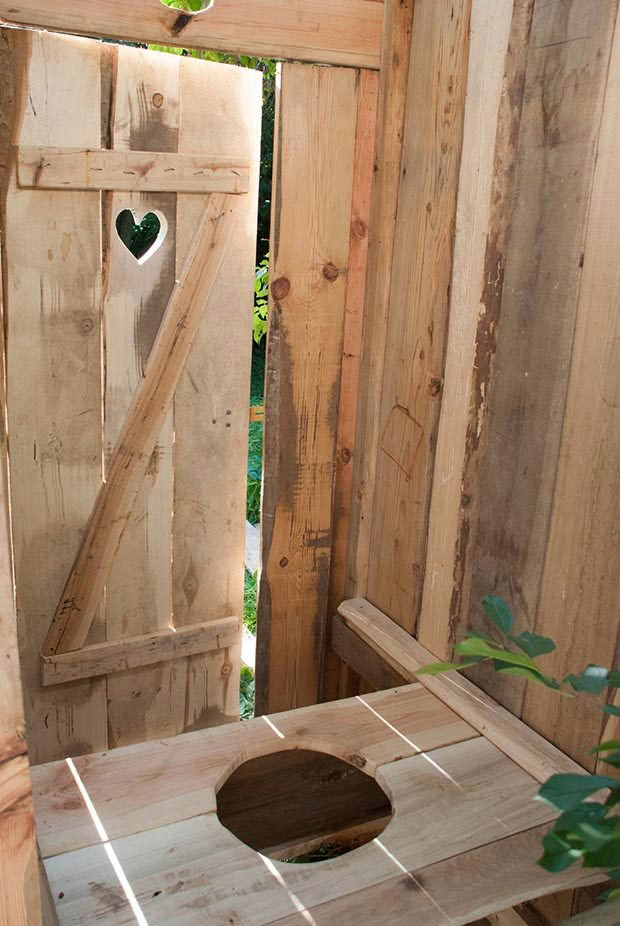
Composting toilets are a sustainable waste disposal for the 21st century. Home owners share their experiences with the next generation of fuss-free, low-odour, environmentally-friendly waste systems — nothing like the long drops of yesteryear.
Words: Nadene Hall
The worst long drop I ever encountered was on the side of a mountain. After 20-odd people had evacuated their bladders and bowels before me, the stench was so thick it felt like a clammy fog. A lot of people have similar stomach-churning memories and it’s long drops they immediately think of when you mention composting toilets says enthusiast Lisa Johnston.
“My dad had that impression, he had used a long drop as a kid and he totally hated it so he perceived that it would be smelly… I mean (in a long drop), you’re pooing and weeing into a hole, you’re not using carbon-rich material, you’ve got this sludgy mess at the bottom of a hole. A composting loo is totally different.”
The modern composting toilet is a no-smell, no-fuss work of art. Use simple design principles and manage it well and you’ll have an eco-friendly disposal system that doesn’t waste or pollute water, and turns your ones and twos into a useful compost.
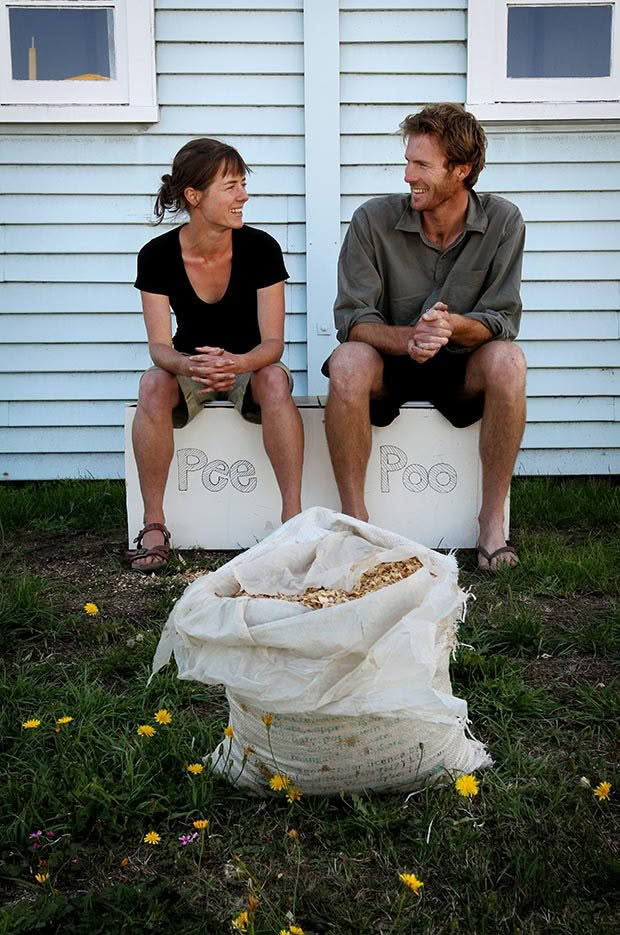
Lisa Johnston and James Bellamy work with a volunteer group called Relieve and have helped with workshops on emergency composting toilets.
Matt King is a builder with experience in the design and installation of composting toilets. Along with Lisa, he’s also part of a group called Relieve which has been collaborating on emergency composting toilet systems since the Christchurch earthquakes.
“There’s quite a distinction between what a long drop is and what a composting toilet is. A long drop is basically an open septic tank. A composting toilet is based around aerobic breakdown of organic matter, like your normal compost you’d have in your garden.
“A composting toilet shouldn’t be septic, it shouldn’t be wet, it shouldn’t be closed up so that there’s no air in it because composting won’t take place if there’s no oxygen around it.”
Composting loos are as diverse as the people who use them. There are systems you can buy that generally come with large storage tanks for cold composting. But a good loo can be as simple as a 20-litre plastic bucket, a toilet box, and a thermophilic (hot) composting regime to break it down.

Nothing to see here – a deposit, covered with sawdust in Lisa and Greg’s home-made loo.
Lisa and her partner Greg Inwood use a bucket composting loo they made themselves, and its design is one they share with people at community workshops Lisa runs for people interested in being eco-friendly with their sewage.
A bucket is encased in a purpose-made macrocarpa and plywood box (hand-made and sold by Greg), and deposits are covered with a carbon-rich cover material like untreated sawdust. Once filled, lids are put on the buckets and they are set aside until there are enough for a ‘batch’ to go into their compost pile, usually eight buckets.
“The batching is really important,” says Lisa. “It’s takes about 10 days for the two of us and guests to fill up a bucket, so it can be sitting there in the buckets for a month or two, then they get transported to the compost heap and they all go in at one time and that triggers a mass of microbial activity. That’s when the thermophilic action – the hot part – happens, and that’s the part that guarantees the pathogens get removed, it’s the heat.”
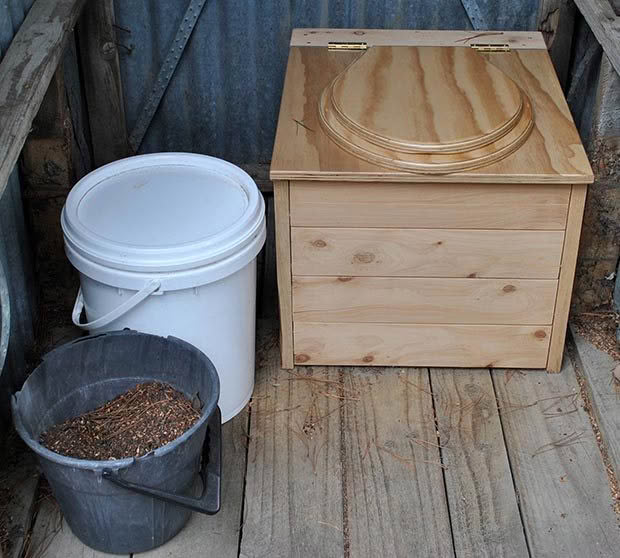
Lisa and Greg’s loo, with a box hand-made by Greg.
The waste products are nested in the middle of a compost pile which is otherwise made up of normal garden waste, coffee grinds and any carbon material Lisa and Greg can find.
This is for two reasons: animals can’t get at it, and also so the waste receives the most microbial activity, ensuring it gets to the thermophilic temperature of about 60°C. Anything over 55°C is enough to kill off most nasty pathogens. However, you don’t want to go too much higher than that or you can limit the rate of decomposition and stop the composting process completely.
Six months later and if you have a look at the centre of the pile, it’s full of compost worms working it over – “you couldn’t recognise it as anything at that point,” says Lisa – and after a year it’s fully cured and ready to use.
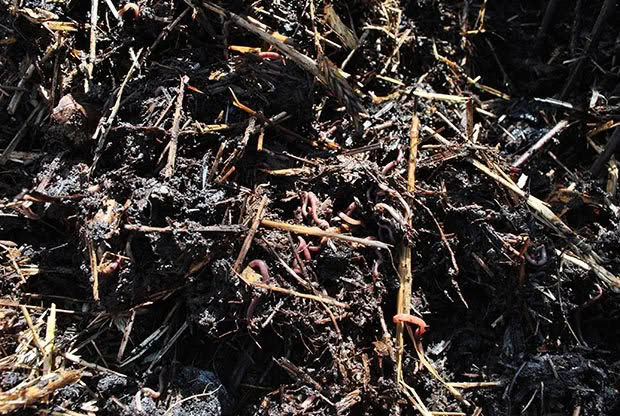
The compost aged 8 months and full of worms.
The only smell is when the buckets are emptied into the compost, but otherwise it’s a smell-free process if you do it properly says Matt King.
“The two things are moisture and air, so if you’ve got those in the right balance then it doesn’t smell.
“In your stomach it’s anaerobic conditions… if you can change that as it comes out of your body to aerobic then the composting bacteria and microbes start to take over… they don’t produce the sulphuric smells that you would get when it’s anaerobic, coming out of your body.
“The pathogenic bacteria, the ones that can cause disease, the ones that cause smell, will start to die off in a proper composting toilet system, and the aerobic ones, the ones that are in your soil and in your normal garden compost, they will start to take over and they don’t actually smell bad.”
Lisa and Greg have a truckload of sawdust in the garden which has lasted them a few years now. A supply is kept in a bucket beside their toilet, and once you’ve finished, you add some sawdust. There’s no smell or any other issues if you follow the rules.
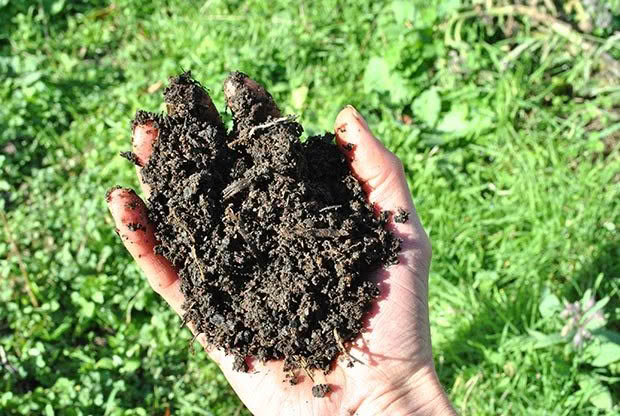
Compost after 12 months.
Getting a permit for a composting loo is dependent on where you live and the type of system you’re proposing, but it’s not the biggest barrier for people when it comes to the compost toilet. That would be persuading all those traumatised former long drop users to give it a go. Lisa says the Relieve team has had huge success with compost loos they’ve supplied to the Splore Festival, a music and art show run annually at a remote regional park in Auckland.
“It’s such a cultural thing,” says Lisa. “We had 10 toilets at Splore this year and that was great. It just gave people a chance to give it a go and most people, once they’ve tried it, they totally love it but it’s just getting through that trial – most people imagine it will be just like a long drop.
“Everybody said it was much better than a portable loo – it served us quite well as a contrast.”
There’s also the aspect of self-responsibility which, if managed properly, isn’t as bad as people think says Matt King.
“My kind of interest is the environmental side of things, and the responsibility of actually recycling our own waste… to be able to take control of that and be responsible with it. Water is a precious resource – a composting toilet doesn’t use any water, or very little water depending on the type of toilet you’re using – and also wanting to be able to recycle the nutrients back onto the land instead of creating pollution somewhere else.”
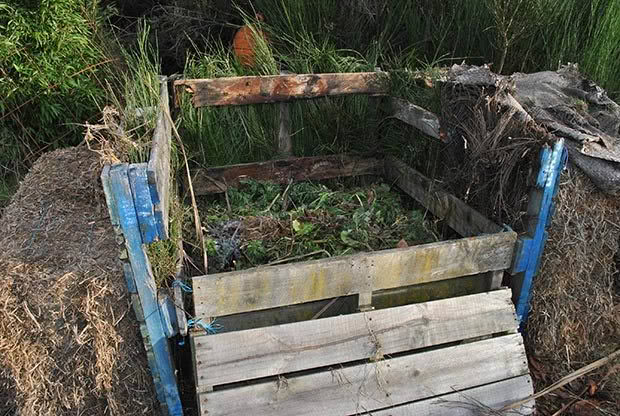
The compost is ready to go thermophilic.
The practical side of things isn’t as scary as people think.
“People have to recognise that a compost toilet system is not a ‘flush and forget’,” says Matt. “There is a degree of personal responsibility and management that goes with it, and I guess you have to be prepared to take it on, but it should never be necessary to really get your hands dirty, mucking around with it. Your system shouldn’t require that if it’s working properly.”
When Lisa holds workshops, she typically gets 15-20 people who are keen to take a look.
“The last thing I want is to have hundreds of people doing it badly – if there’s only five people who do it properly then that’s all I want to do it.
“We’re always reinforcing the idea of ‘best practice’. The fact is, if you’re doing it now you’re a pioneer in New Zealand so we’ve got to do it well so we’re not screwing it up for everybody else, creating the culture of doing it properly.”
3 TIPS FOR CHOOSING A COMPOSTING LOO FOR YOU
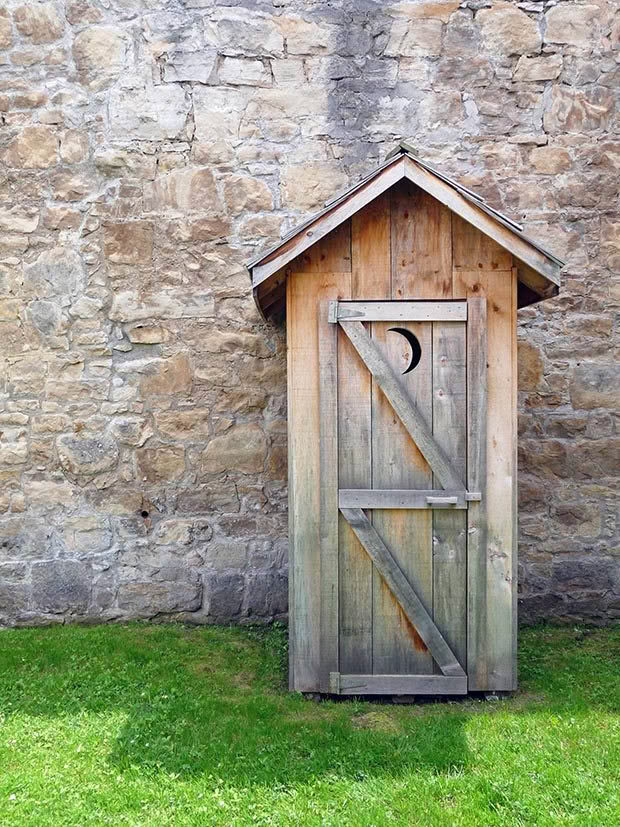
1. Choose the one that fits the space you have available
Composting loo systems come in all shapes and sizes and may need more room than you have in your current bathroom or toilet area.
2. Choose the one that suits your home’s structure
Some commercial composting toilets are made to be fitted on a concrete pad, while others require room for a chamber under the floor.
3. Choose the one that suits your level of involvement
One family member may be super keen, one may not. The compromise can be a composting system that does some of the work for you, such as having an extractor fan to dry the compost.
Others can have separate compartments if you’re just urinating.
Matt’s tip is to go for one that has the least number of moving parts.
“If something breaks down then obviously it’s a lot more tricky to fix because it’s right in the middle of a toilet. I find the simpler, the better.”
COMPOSTING TOILETS AND THE RULES
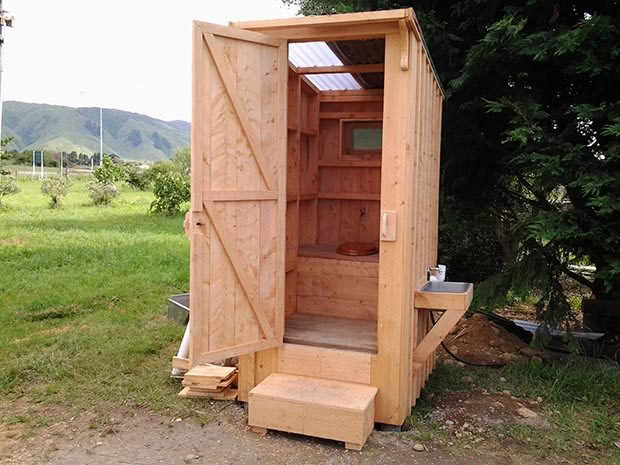
One of Matt King’s composting toilet sheds, built for a client.
Councils can be very wary about composting loo systems. If you’re building a new house you’ll need to get consent and to have the toilet system you choose signed off by an engineer who is accredited or approved by your council.
After the 2011 Christchurch earthquake, the Relieve team helped out by teaching people how to make their own emergency composting loos.
“We did a lot of education work in Christchurch,” says Lisa. “Through that process I looked into the rules… and from what I can see, basically the rules are you need to have a permitted toilet for a building consent so that’s the only point where something is triggered. If you have a toilet already, like a flush toilet or a septic tank or a commercial compost toilet that’s been permitted, there’s nothing at all to stop you from doing the system that we have because no-one says what you can and can’t put in your compost heap and no-one says what you can put in a bucket either.”
Lisa is keen to work with councils on the rules around composting loo systems.
“Even though (our system) is much more effective than a commercial compost toilet, the effectiveness is entirely dependent on the manager of the toilet.
“When it comes to these systems, I think it’s not the toilet that should be consented but the person who should be consented as a composting toilet manager.”
THE RULES OF THE COMPOST TOILET
- Please take a seat & make your deposit.
- Toilet paper goes in the toilet too.
- Menstrual pads & tampons go into the rubbish bin.
- Lift the toilet lids and cover your deposit well with a couple of scoops of cover material.
- If you have peed, add in extra cover material to soak it up.
- It is important that no chemicals, deoderisers, plastics, or anything inorganic go in this toilet.
- Thank you for your valuable contribution!
Case study 1
Who: Joy McLeod
Where: Waikanae
System: Aquatron, www.ecotoilets.co.nz
Our plan for a suitable sewage system for our sloping one hectare block had to satisfy two main conditions: my husband’s desire for an environmentally sound waste disposal system, and my insistence on a flushing toilet!
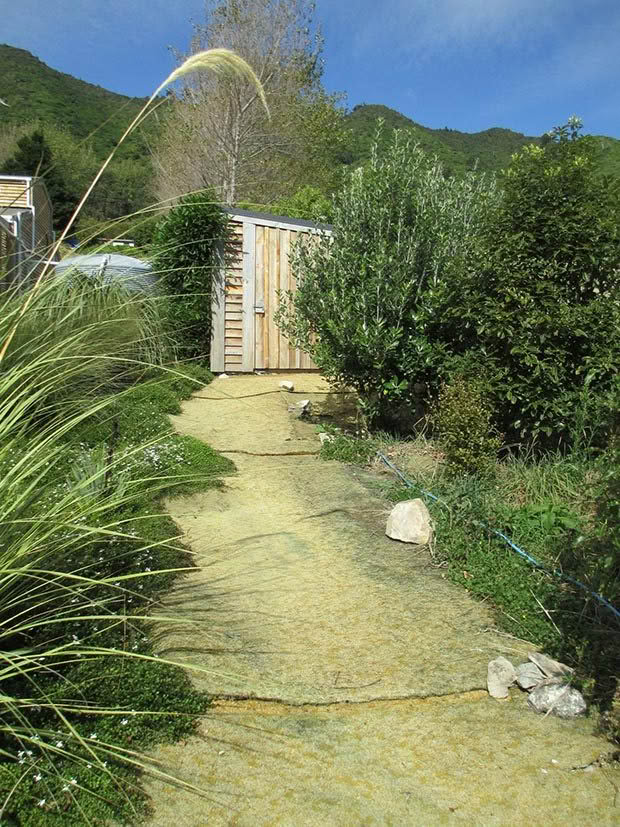
A view of the ‘bog shed’ holding the Aquatron unit.
Systems available in New Zealand were expensive to install and required regular servicing. Trawling the internet, we came up with the Aquatron, a Swedish-made automatic unit in which the solids are gradually turned into compost by the action of worms. The separated liquids are channelled into an ultra-violet sanitation unit and regularly released into a 140m² evaporation/transpiration field which we filled with a variety of reeds, grasses, sedges and other moisture-loving plants. With such a nutrient-rich environment, the growth has been phenomenal.
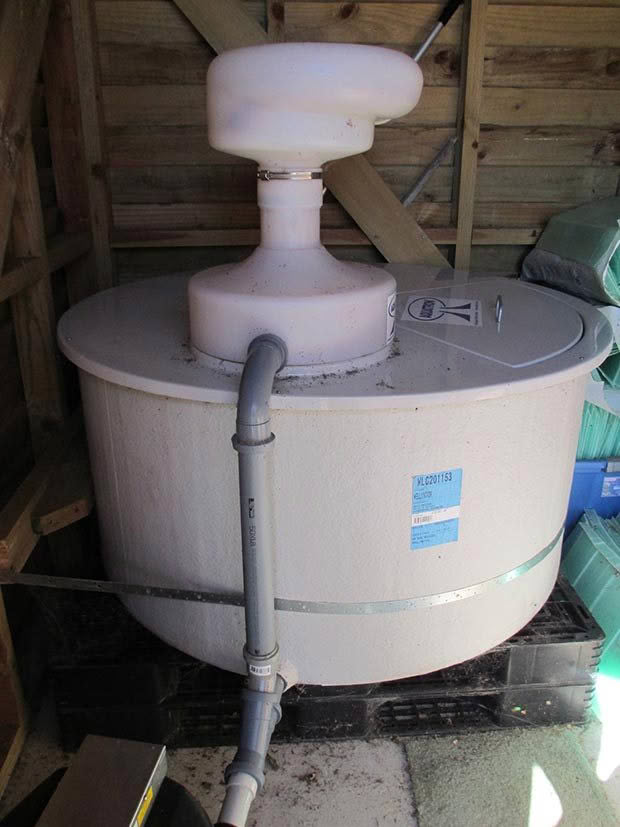
The Aquatron unit.
The grey water from the shower and washing machine also flows into the evaporation field, and the resulting compost from inside the unit is ready to put on the flower garden after two years. The unit resides in its own little building (our ‘Bog Shed’), which with the growth of climbing plants and surrounding trees has almost disappeared from sight.
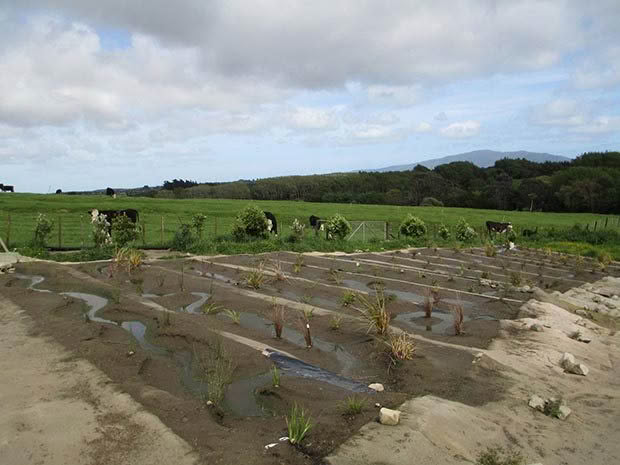
The transpiration field is filled with moisture-loving plants.
We’re very happy with our eco-friendly system, and the view across our thriving bog garden gives us both pleasure and a sense of achievement.
Case study 2
Who: Peter Thornton
Where: Kenepuru Sound, Marlborough Sounds
System: Sun-Mar Centrex 2000 composting toilet
Installation: 2010
Our Marlborough Sounds property is reliant on rainwater only, has solar power, and no road access. The last long drop toilet hole had filled up with less than three years continuous use.
We wanted a no-water, no-power system for two-person continuous use, and also dug a new hole for the long drop to avoid overloading when we have family or guests.
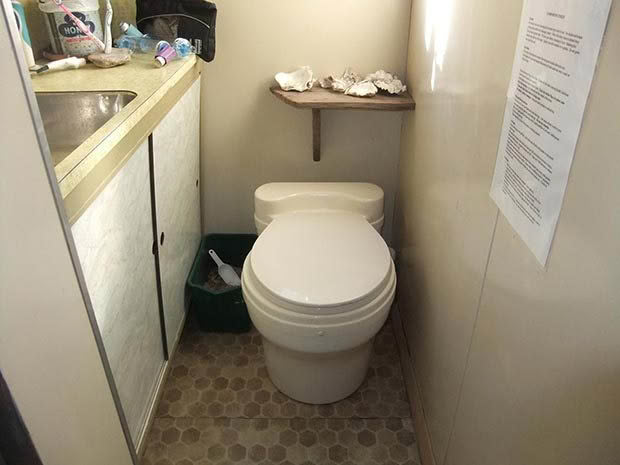
What you see inside: a normal-looking toilet.
We chose a Sun-Mar Centrex 2000 because the advertising literature said no smell and virtually no liquid. It was also recommended by a friend who has the smaller free-standing unit for intermittent use, and the model we bought fitted the space available.
The system has a normal-sized toilet seat over an underfloor container and drum. A 2.4-watt fan draws air down the toilet bowl and through the container.
When you use it, you add a mixture of wood shavings and peat, one cupful per person per day, and the drum is rotated twice a week. The literature says to take the product off every two months by rotating the drum backwards to drop a load into the finishing drawer, where it dries and matures until the next load is removed. Sludge from the floor of the container is also removed every two months.
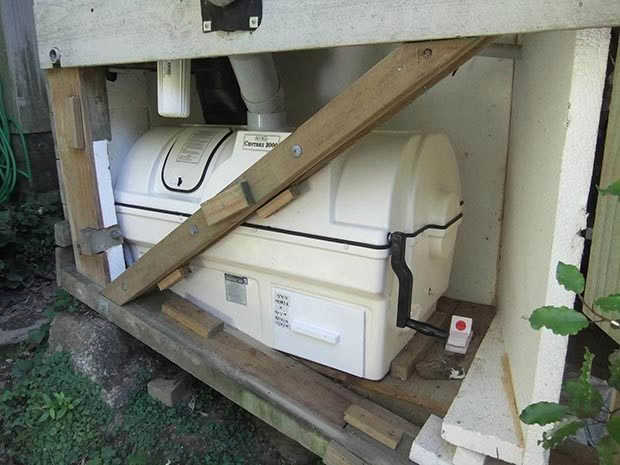
Under the floor directly below the loo is the composting unit.
We tried for over a year to make it work to specification but the two of us seem to produce too much waste.
We installed the toilet bowl at right angles to the drum to suit the room available. We added rubber flaps each side to direct pee through the slot.
In time the rubber curled and pee leaked over the outside of the drum to collect in the drawer. This defeated the purpose of the finishing drawer so we removed it and fitted a plywood hatch over the opening.
Although we only have a handful of very light frosts, the system went anaerobic in winter so we insulated around the container with 50mm polystyrene. On cold nights we fill a 10-litre container with hot water and put it in the box before going to bed. On sunny days we open the east side of the box to let in the morning sun.
For shavings we use pine or whiteywood cut along the grain, which is then mixed 4:1 shavings with forest floor litter, plus half a cup of lime. A handful is dropped down the toilet after each use. A tablespoon of blood and bone and a teaspoon of active yeast are added once a week on different days.
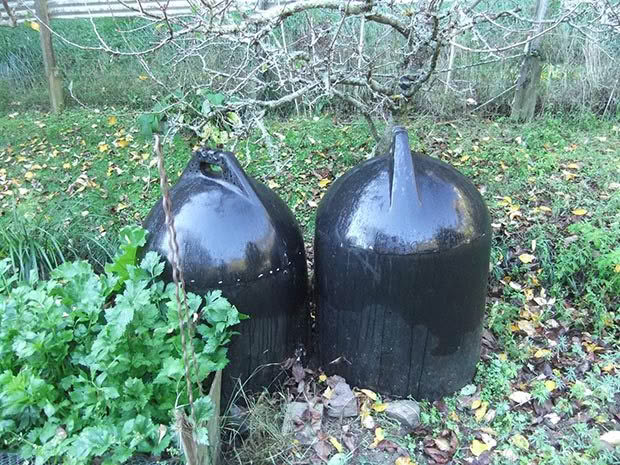
Peter’s unique compost bins, made out of old mussel buoys.
What we have found is the waste rolls into balls in the drum, and if left they do not fit through the slot that leads to the finishing drawer. The balls then have to be dug out from the underside of the drum with a fire shovel, an awkward and messy business. We have overcome this by raking the mixture once a week.
Every two months we do a ‘dunny dump’, taking out four drawers full of waste to leave the drum quarter full. The product is transferred to a compost bin, worms are added to the first dump, and each layer is covered with green waste.
We have two bins made from mussel buoys (about 250 litres each). One bin will easily hold a year’s waste and we fill them year about. After one year maturing, the bin is emptied to the vege garden but we don’t grow root crops in it the first year.
The path to the back door goes past the container and there is sometimes an odour. There is no smell inside the house except for the occasional down draft in a northerly storm.
It smells inside the house when the bin is open for a ‘dunny dump’ but a plastic bag under the toilet seat controls this.
So the system works after modifying the operation to our conditions but is labour intensive.
Case study 3
Who: Angela Stevens
Where: Canterbury
System: Kakapo
Installed: 2007
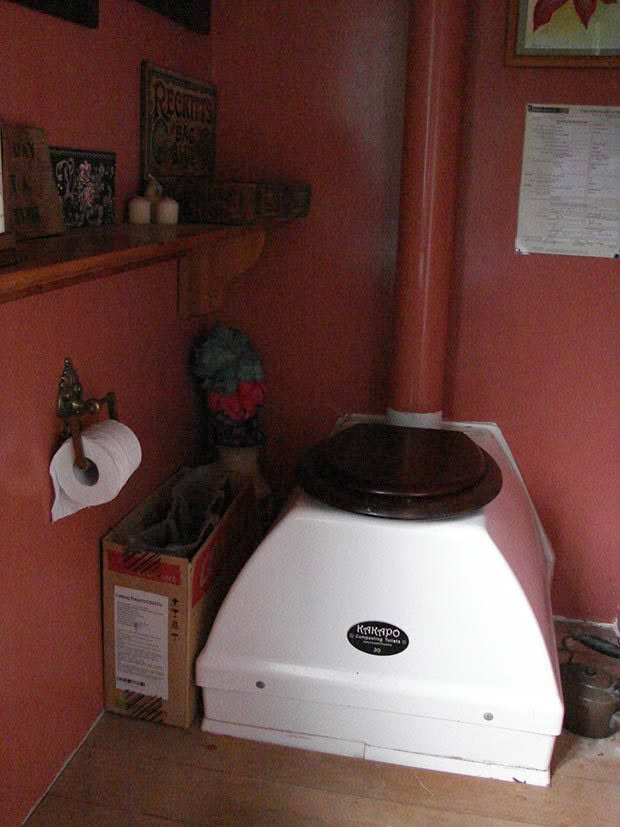
Angela’s Kakapo loo.
We have had a very successful compost toilet for seven years.
There is a pub in Takaka called the Mussel Inn where one can partake of beautiful food, and it’s also a successful music venue. The public toilets are composting toilets called ‘Kakapo’. The owners of this venue designed and built them, although I believe they have sold their toilet business to a company in Dunedin now.
We are about to move from our current home and we shall be looking for this firm in order to install one in the next place. There is a septic tank already but we much prefer to recycle valuable nutrients to the soil.
Our current Kakapo toilet separates the urine from the solids, thereby preventing putrification. The seat is positioned at one end and the outlet at the other.
After each solid deposit, the paper and sawdust, straw, hay or other organic material is added and a suitable carbon-to-nitrogen ratio is maintained. This travels along the drum which is periodically rotated to overflow into a receptacle inside the door for easy emptying.
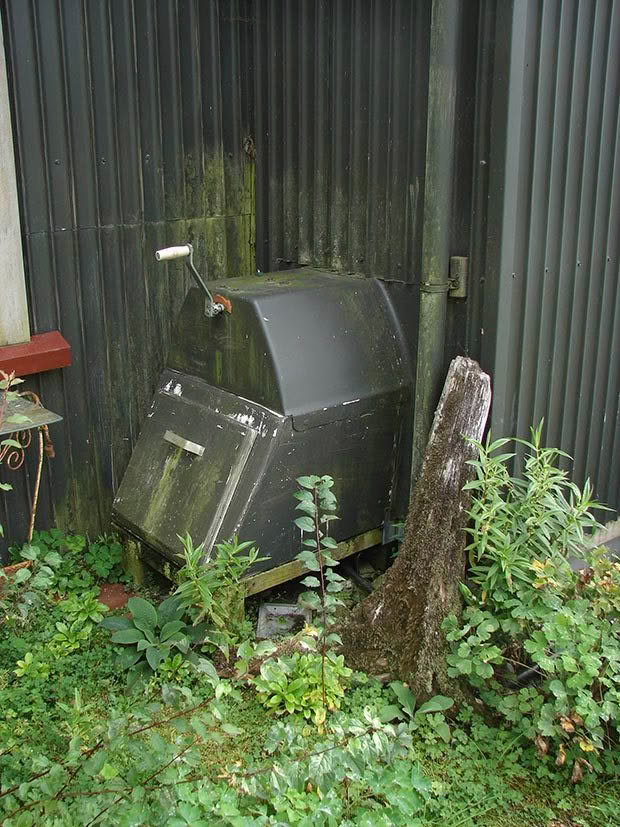
Behind the toilet wall is the compost unit.
There is a vent (referred to as our ‘scud missile launcher’ by a comic that we know) which draws air through the seat from the surrounding room and I promise you there is no odour. There is no need for fans so no batteries or electricity needed.
The solids are put on the compost heap and the urine can be poured over it – it’s an excellent activator – or sprayed on the pasture.
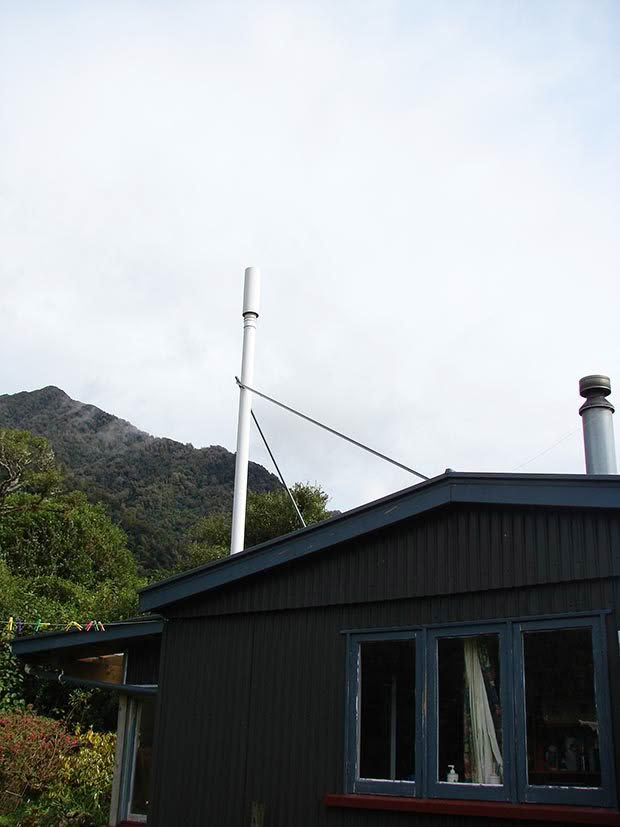
The vent, or the scud missile launcher as it’s affectionately called.
We use the wetlands method of treating greywater because it’s energy efficient, practical and efficient. Plants that thrive in the environment act as filters and the microbes on their roots do most of the work breaking down nitrogen and phosphorous compounds, as well as toxic chemicals.
The wet area has boulders and shingle as a base, and the water filters through the plant roots. This area has functioned for seven years without any smell or ponding. All the house roof water goes through the same system which does help with keeping the water clean.
ANGELA’S NUMBER ONE TIP
If you’re considering a composting toilet, Angela recommends doing some research. “There is a great book by Joseph Jenkins called the Humanure Handbook which is well worth a read.”
You can buy the latest edition, or read an older edition for free from Joseph Jenkin’s website.
You can also watch a range of videos on Jenkin’s composting toilet system on youtube.
Case study 4
Who: Bryan Taylor
Where: Hikurangi, Northland
System: Kiwibog
Installed: 2012
We have a Kiwibog toilet and are really happy with it. It is a very simple urine separation toilet that everyone has to sit on to use. No water is harmed in the use of our toilet!
Once a month we empty a corn starch bag with the soils and feed our composting worms located in the garden.
We did a DIY job with the help of a builder friend who cut the hole in the roof (our loo is inside and looks ‘normal’) but it’s not an issue if placed outside. Our off-grid power system copes with the fan, but they also have self-contained solar options as well.
It’s so much better than our previous toilet (installed 16 years ago) where the liquid separation wasn’t working and the worms couldn’t get their snorkels on in time – messy, messy, messy. It was an Aquatron flushing loo with liquid separation and a composting box for the worms. The separator unit never really worked well – too much liquid got in, the worms drowned etc. The couple of times it did work we took fresh vermicast out the front of it, but the other 10 or so times we removed raw sewage.
A company rep came a few times and tinkered with it, then our calls stopped being answered. I think the business has since changed hands.
3 TIPS FOR THE CARE Of THE GREYWATER SYSTEM
Keep as much organic material out of the water as possible – never use an in-sink garbage disposal, and compost grease, fat and oils. A household drain is not a waste disposal site — do not allow any toxic chemicals to enter the drain system. Use biodegradable soaps and environmentally benign cleaning agents.
It is inevitable that a small amount of organic material will go down the drain from dishwashing – this is collected in a sieve and composted.
Love this story? Subscribe now!
 This article first appeared in NZ Lifestyle Block Magazine.
This article first appeared in NZ Lifestyle Block Magazine.
